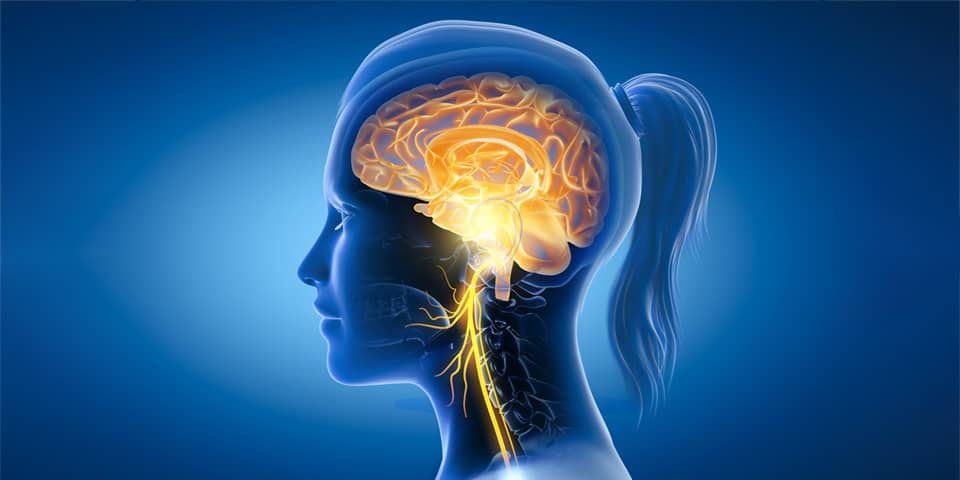Interoceptive Awareness and the Vagus Nerve: Important Elements in the Diet-Mental Health Relationship

Referred to as our “eighth sense,” Interoception is our perception of the internal physiological state of our bodies. It involves the receiving, encoding, and representation of internal bodily signals in the brain and nervous system, as well as our perception of these states (Ceunen et al., 2016). Interoception encompasses non-conscious bodily signals occurring, and our conscious perception of them. These signals play a role in motivating our behavior — including our dietary intake (Paulus & Steward, 2014).
Interoceptive signals play a role in motivating our dietary intake behavior.
While the physiological characteristics and applications of Interoception are not yet fully understood, the vagus nerve gives us insight into this bidirectional communication consisting of a complex, bodywide system of nerves and hormones. A massive network of fibers, the vagus nerve travels from nearly every internal organ to the base of the brain and back again. It regulates many autonomic functions including heart rate, breathing, and digestion. More recently these vagal fibers have been found to go beyond the brainstem, showcasing a network in the brain that interprets internal changes, anticipates the body’s needs, and sends commands to fulfill them. This vagal network even expands into more complex cognitive systems, revealing insights into how we remember, process emotion, and construct our sense of self (Underwood, 2021).
This vagal network even expands into more complex cognitive systems, revealing insights into how we remember, process emotion, and construct our sense of self (Underwood, 2021).
Due to the vagus nerve being involved in both the body’s basic autonomic functions and also these higher cognitive systems, it has become of interest for treating many different conditions. Vagus nerve stimulation (VNS), which sends pulses of electricity to the vagus nerve has already been approved to treat depression and epilepsy. Other less invasive ways of stimulating the vagus nerve are currently being studied for rheumatoid arthritis, obesity, and Alzheimer’s. However, stimulating the vagus nerve has its limits, as the side effects can be vastly different (Underwood, 2021).
When it comes to stimulating the vagus nerve, and thereby increasing Interoceptive Awareness (Paciorek & Skora, 2020), there are less invasive ways to do so such as mindfulness, including meditation, breathing exercises, and body scans. These exercises can have a significant effect on vagal tone, and tend to activate the Insula — an area of the brain thought to be the hub of Interoception (Craig, 2009).
Eating high-quality, nutritious food is another way to increase your brain-to-body connection, and improve your vagal tone.
Eating high-quality, nutritious food is another way to increase your brain-to-body connection, and improve your vagal tone. This gut-brain axis is what allows the bacteria in your gut to communicate with your brain (Breit, 2018). Gut microbes also play an important role in your immune system and inflammation by controlling what is passed into the body and what is excreted (Rooks & Garrett, 2016). When you eat a typical Western-style diet categorized by high-sugar, high-fat foods, you are setting yourself up for inflammation in the body (Myles, 2014). By choosing to cultivate healthy gut bacteria through proper nutrition, you can strengthen your vagus nerve, thereby increasing a significant part of your Interoceptive Awareness. This can improve your Diet-Mental Health Relationship, leading to enhanced well-being and mental health.
When you eat a typical Western-style diet categorized by high-sugar, high-fat foods, you are setting yourself up for inflammation in the body (Myles, 2014).
Learn more about the role of Interoception within Nutritional Psychology in NP 110: Introduction to Nutritional Psychology Methods, and the role of the vagus nerve is NP 120: Gut-Brain/Microbiome Axis and Mental Health (coming Fall of 2021). Thank you to CNP Contributor Chelsea Louise Doswell for this article.
References:
Breit, S., Kupferberg, A., Rogler, G., & Hasler, G. (2018). Vagus Nerve as Modulator of the Brain-Gut Axis in Psychiatric and Inflammatory Disorders. Frontiers in Psychiatry, 9, 44. https://doi.org/10.3389/fpsyt.2018.00044
Ceunen, E., Vlaeyen, J. W., & Van Diest, I. (2016). On the origin of interoception. Frontiers in Psychology, 7, 743. https://doi.org/10.3389/fpsyg.2016.00743
Chen, W. G., Schloesser, D., Arensdorf, A. M., Simmons, J. M., Cui, C., Valentino, R., Gnadt, J. W., Nielsen, L., Hillaire-Clarke, C. S., Spruance, V., Horowitz, T. S., Vallejo, Y. F., & Langevin, H. M. (2021). The Emerging Science of Interoception: Sensing, Integrating, Interpreting, and Regulating Signals within the Self. Trends in neurosciences, 44(1), 3–16. https://doi.org/10.1016/j.tins.2020.10.007
Craig A. D. (2009). How do you feel–now? The anterior insula and human awareness. Nature reviews. Neuroscience, 10(1), 59–70. https://doi.org/10.1038/nrn2555
Emily Underwood. (2021). Newly detailed nerve links between brain and other organs shape thoughts, memories, and feelings. Science. https://www.sciencemag.org/news/2021/06/newly-detailed-nerve-links-between-brain-and-other-organs-shape-thoughts-memories-and.
Myles I. A. (2014). Fast food fever: reviewing the impacts of the Western diet on immunity. Nutrition Journal, 13, 61. https://doi.org/10.1186/1475-2891-13-61
Paciorek, A., & Skora, L. (2020). Vagus Nerve Stimulation as a Gateway to Interoception. Frontiers in Psychology, 11, 1659. https://doi.org/10.3389/fpsyg.2020.01659.
Paulus, M. P., & Stewart, J. L. (2014). Interoception and drug addiction. Neuropharmacology, 76, Pt B(0 0), 342–350. https://doi.org/10.1016/j.neuropharm.2013.07.002
Rooks, M. G., & Garrett, W. S. (2016). Gut microbiota, metabolites and host immunity. Nature Reviews. Immunology, 16(6), 341–352. https://doi.org/10.1038/nri.2016.42








Leave a comment